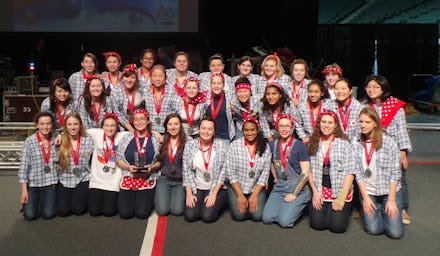Meet the Teen Girls Busting the Biggest Stereotype in Science and Tech

The season for competitive robotics is here.
In a larger climate where women face discrimination in a number of science, technology, engineering and mathematics (STEM) fields and have a high dropout rate, a growing number of all-girls teams are entering robotics competitions — and winning. Girls of Steel and Exit 5 Robotics are just a couple of the all-girls teams beating out the boys. They’re challenging the backwards idea that girls struggle in STEM, one circuit at a time.
If you haven’t seen it before, the FIRST Robotics Competition is one of the biggest of its kind. The new season officially gets underway in January and teams around the country are starting to prep for the 2015 season. Teams around the world design and build their own robots to compete in the annual championships.
For Inspiration and Recognition of Science and Technology, or FIRST, is an organization founded by inventor and entrepreneur Dean Kamen in 1989. It seeks to inspire young people to take an interest in STEM and hosts robotics competitions throughout the country, including the world championship each spring in St. Louis. Out of 2,700 total FIRST Robotics Competition teams, there are 31 active all-girls teams.
Girls of Steel is one of them. Founded in 2010 at Carnegie Mellon University, the team originally consisted of 24 girls from 12 different high schools. Team members write code, use advanced software and weld. Last season, the team built a robot called Atlas that could pass balls and score on a low goal. For the fourth year in a row, Girls of Steel made it to the world championships.
Image credit: Girls of Steel. Team members flex for the camera.
“[Usually] most drivers [of the robots] are male and even more of the coaches are,” one Girls of Steel team member told Mic. On teams like theirs, women do it all.
Girls of Steel kicked off its fifth season Sept. 23, with a team of 55 girls from 29 schools. The girls are meeting once a week to learn the skills to work on different subteams, like electronics and programming, according to Theresa Richards, a Girls of Steel mentor. Starting in January, they’ll kick off the six-week build season where students design, assemble and test the robot that they’ll enter in the competitions.
Image credit: Girls of Steel. Team members work with an adviser on their robot, Atlas.
Another all-girls team, Exit 5 Robotics, was founded by engineer Bill Lam and his daughter Chloe in 2010. The team had five members when it started. Four years later, Exit 5 has 22 members from grades eight through 11 and there's a second team for younger girls.
The father-daughter pair chose to start an all-female team because in mixed-gender groups, boys tend to take over the robot-building process, leaving the girls to do documentation or research.
“At the end of each year as we discuss recruiting, I ask the team if they want to add boys to team,” he said. “The answer is an immediate and resounding ‘No.’”
Exit 5 is the most consistently successful robotics team in New Jersey, Lam said, but the team still faces gender discrimination at competitions. While testing out a robot at the Liberty Science Center in Jersey City, a parent came up to him and asked, “Who built the robot?”
Lam explained that two four-year veterans on the team built the robot in just a few hours.
“His interrogation not only revealed the truth about who built it, but more importantly revealed a very disturbing undertow of gender bias in STEM,” Lam said. “He walked away in disbelief. I stood there in disbelief.”
Image credit: Exit 5. Team members hard at work building their own 'Mars Rover.'
But for the girls on the team, none of that matters. Chloe said she thinks many of her teammates will go on to STEM majors in college. Being on a robotics team has given them options, she said.
“After being on a robotics team for four years, I can’t imagine a life without thinking about how to improve our robot or how to fix a problem,” Chloe said. “It’s completely different from what many other girls my age are doing over their weekends, and that makes me happy.”
The makers of the next Mars Rover are already hard at work. The future of women in STEM is looking better and better.
This story is a collaboration between Mic's branded content team and Cole Haan; it was not written or created by Mic's editorial staff. To learn more, visit our Branded Content FAQS page.